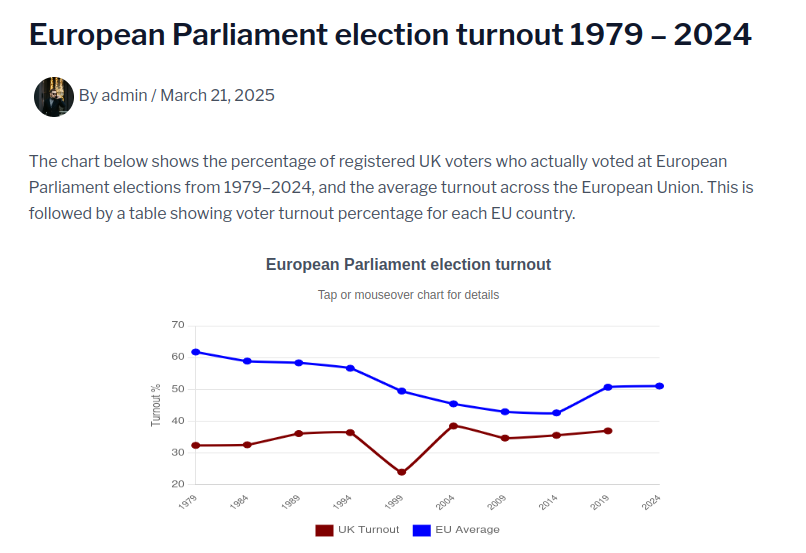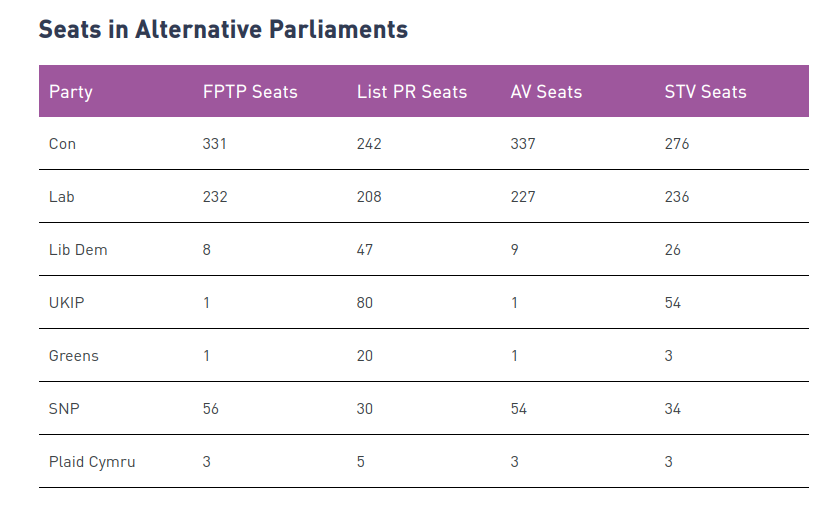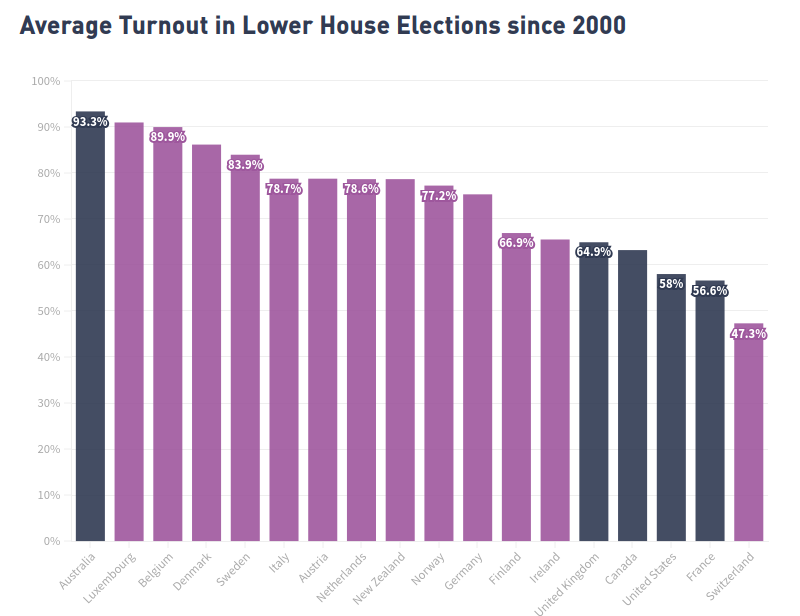In my last post, I expressed a preference for the single transferable vote. So let’s look at the competition (a more detailed look at each from the Electoral Reform Society can be found here):
Party List Proportional Representation
Variants of this are the most common types of voting system in the world, being used in 80 countries. In the closed list variant, people just vote for parties and the parties then supply candidates in proportion. An open list system has a list of candidates to vote for, the vote both determining the party vote and ordering the candidates which are then supplied according to their proportional vote. A semi-open system means parties publish the order in which their candidates will be supplied but voters just choose parties. Constituency size also affects how these systems work.
The closed list system was used in the UK for European Parliament elections until we left the EU. These elections had consistently low turnouts in the UK and only about 5% of people were able to identify their MEP. So I think that probably disallows these systems for the UK.

Additional Member System
This is first past the post but with additional MPs added to make the overall numbers for each party proportional to the popular vote, arrived at with a second vote for a party on a party list basis, with all its disadvantages.
Imagine how many more MPs would have been required to make the last election proportional! For the 412 Labour MPs to only represent 34% of the seats we would need 1,212 in total, an increase of 562 (ie almost double). This, combined with the disadvantages of the party list system, disallows it for me I think.
Supplementary Vote
You get two votes instead of one, first choice is FPTP. If noone gets 50% of the vote, there is a run off between the top two where second choices are then added on to the candidates’ totals (although if your first choice is in the run off, your second choice is not counted). It is used to elected the London Mayor which obviously doesn’t required proportionality. Which is good, because it does not remotely provide it.
Alternative Vote
If noone gets 50% of the vote, the candidate who came last is removed and their votes allocated according to the second choices of the people who had that candidate as their favourite. And so on until someone does get 50%. However it is not a form of proportional representation as the ERS re-running of the 2015 election under a number of different systems shows:

Also, we have already voted against introducing this system (in 2011).
Alternative Vote Plus
This was a system invented by the Independent Commission on the Voting System (often referred to as the Jenkins Commission as it was chaired by Roy Jenkins) in 1998, which has never been implemented anywhere. It recommended using the Alternative Vote system for 80-85% of the seats in Parliament, then topping up from party lists to make the system proportional. Unfortunately, as ERS have pointed out, 15% of the seats would not be enough to achieve this.
Two-Round System
This is very similar to the alternative vote system, where if noone gets 50% of the vote in the first round, the top two candidates go through to the second round, with people’s second choices reallocated where their first choices did not make the top two. It is therefore not a proportional system. It also introduces a gap between the first and second vote, with uncertain consequences.
Borda Count
In this system there is one ballot paper with a list of candidates. You put a number next to each candidate, with your favourite at number one. These are converted into points with the candidates ranked last scoring one point, two for being next-to-last and so on. The candidate with the most points is the winner.
It is a recipe for tactical voting and is used in Eurovision – need I say more?
So how do these compare with the single transferable vote?
Single Transferable Vote
First a link to the video from my last post, explaining how it works, as a reminder (I highly recommend it and it is under 7 minutes long).
In this system, you have multiple seats per (larger) constituencies, with constituencies the size of 4-5 current constituencies. As a voter you number the candidates (you must vote for one and then its up to you). There is a quota (known as the Droop quota after its inventor Henry Droop) which is calculated as:
total votes / (total seats + 1)) + 1
This wacky formula is to adjust the normal requirement for a single MP election for them to get more than 50% of the vote to one where there are multiple seats available, and the “+ 1” is there to replicate the “more than” requirement.
If a candidate gets at least this number of votes, they are elected and their surplus votes (ie the ones in excess of the quota) are then reallocated to your second choice candidate. If noone reaches the quota, then the least popular candidate is removed and their votes reallocated until someone does.
The constituency should then end up with MPs approximately in proportion to the percentage vote of each of their parties (although independents can operate successfully within this system too).
This is a proportional system which still gives you a link to your MPs. The larger constituencies can line up with existing areas which make sense to voters, eg in Birmingham there are 10 constituencies currently within the Birmingham City Council region, which could be combined into two larger constituencies each represented by 5 MPs in proportion to the votes in each area.
I must get a couple of requests a week from campaigners to write to my MP in support of their latest campaign. My own experience of writing to my MP, who has a well organised and efficient office but has been in the role for a long time and feels he knows his own mind about most things by now, is the most I can expect is a return letter telling me all of the reasons why I am wrong about my position on whatever it is. Imagine a constituency where most of you had the choice of an MP who shared at least some of your concerns and was therefore more likely to help represent your views more widely. Imagine how much more empowered you would feel, how much more likely to get involved in politics, how much more likely to vote.
Imagine that effect rippling throughout the constituencies up and down the country. Imagine what it might do to voter turnout!

Is proportional representation (PR) likely to lead to more representation for smaller parties and therefore coalitions? Yes it is. But the mistake is in thinking that FPTP doesn’t lead to coalitions. The difference is that they are currently within a few big dominant parties trying to hold their different wings together on the left and the right. With PR those deals need to be done in public so that we can judge them and adjust our votes accordingly.
The Jenkins Commission mentioned earlier ended up rejecting STV on the basis that it moved to bigger constituencies (which does not seem a disadvantage in itself), had a more complicated voting system (which can be fully explained in a video under 7 minutes long) and “a tendency towards parochial politics”. It seems to me that time has moved on. The challenges we are facing increasingly are going to need local community responses. What Lord Jenkins might have called “parochial” from his rather lofty view of politics may be just what we need now.
Instead imagine that your vote counted at the next election even if you weren’t in the majority. Imagine most people having a sympathetic MP they could write to about things that mattered to them. Imagine MPs encouraged to represent the views they stood for election on to the full extent of their ability – no more having to sit in one or two buckets that aren’t really what they’re about because they are the only buckets that ever get elected. Imagine that all political parties win the proportion of seats they have earned as a result of their proportion of the vote, no more and no less. Imagine being able to vote for the party you prefer rather than needing to tactically vote to keep out your worst nightmare. All this could be yours.
All we need to do is demand it!
